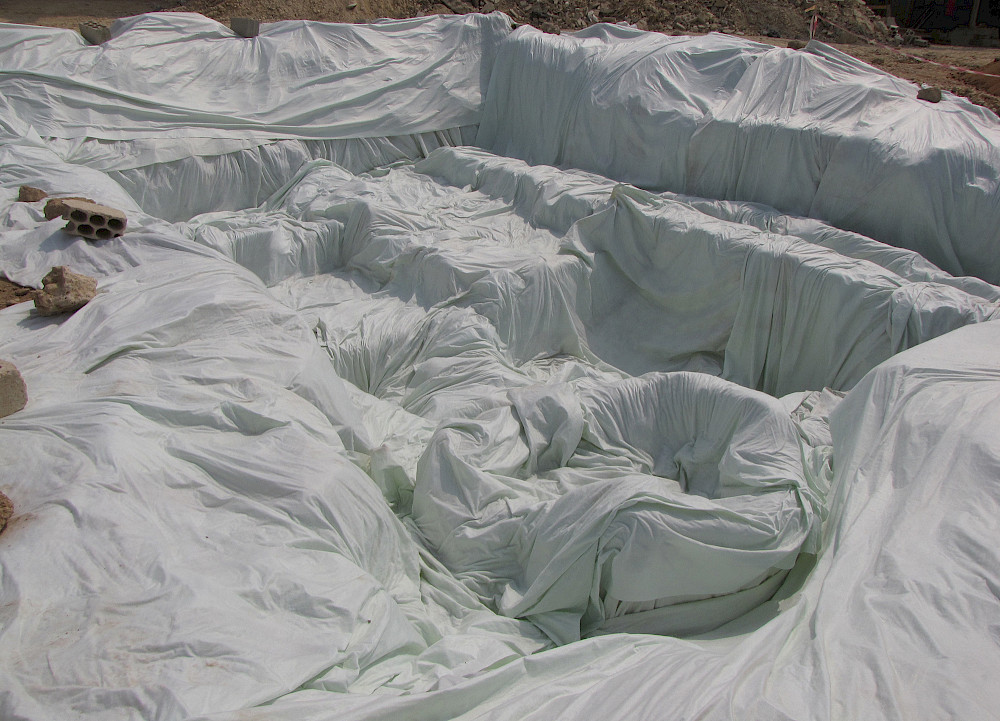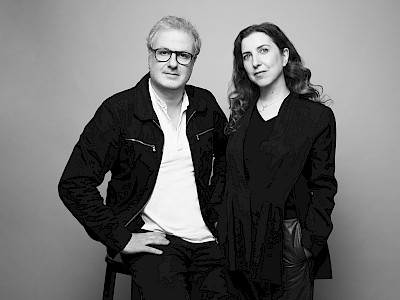19 — 22.05.2024
Joana Hadjithomas, Khalil Joreige Beirut-Paris
La vertigineuse histoire d’Orthosia
visual arts / performance — premiere
This story unfolds in the north of Lebanon, at Nahr el Bared, in a refugee camp hastily set up to shelter Palestinian families fleeing the Nakba of 1948. Years later, in 2007, war broke out between the Lebanese army and an infiltrated Islamist group, leading to the destruction of part of the camp. It was at that moment that the first traces appeared of Orthosia, an ancient Roman city, which vanished after being overwhelmed by a tsunami in 551 AD and which, despite 15 centuries of vain attempts to find it, no-one could ever have imagined finding there. But how best to deal with this major discovery, as excavations would mean a ‘second displacement’ for the refugee families? The filmmakers and artists Joana Hadjithomas and Khalil Joreige use photography, installations, video and cinema to question the account of the imagination and writing about the story. Through this performance, created for the festival, they uncover the palimpsest of constant cycles of construction and destruction, calling on the possible narratives about the underground worlds. A dizzying performance, full of (dis)continuities, upheavals and regeneration, which plunges us into a past that feels particularly close to the present.
La vertigineuse histoire d’Orthosia
As is often the case in your projects, La vertigineuse histoire d’Orthosia [The Breathtaking Story of Orthosia] has come about from encounters you had while undertaking previous research. What triggered your interest in Nahr el Bared?
Our work explores narratives and constructions of imaginations, especially when the story is problematic or complex. Each time, borrowing other gazes and bringing together disciplines has allowed us to learn to see things differently, with some collaborations bringing about transformations and the discovery of new tools. We met the archaeologist Hadi Choueiri on a building site opposite our home in Beirut. Our practices fed in to each other. Later, Hadi was asked to work on an archaeological dig in Nahr el Bared. That’s how we found out about this incredible story and have followed all its breathtaking developments.
There’s plenty of room for encounter, chance and collaboration in what we do.
Your work can be seen as research into artistic, theoretical and political issues linked to the gesture of showing stories that have become invisible. This show is about the discovery of the remains of the city of Orthosia in the middle of a refugee camp, in the ruins of war, and the collective decisions that are going to be made. What does La vertigineuse histoire d’Orthosia show? What did this project teach you about the gesture of showing?
Giving a physicality or a form to what you cannot or no longer know how to see, bringing a certain imagination to life has always been at the centre of our practice, just like the desire to create representations that are closer to us, that resemble us.
In La vertigineuse histoire d’Orthosia, it’s about a city that was swallowed up by a tsunami and emerges preserved 1500 years later under a Palestinian refugee camp.
This story questions our relationship with different temporalities, past and present, the geopolitical madness in the region, traces, transmission, reconstructions and heritage, but also the constant cycles of catastrophe and regeneration. We’ve always wanted to reflect the complexity of realities that didn’t meet the conditions for visibility. Because you have to have a context that permits a perception; it’s a revelation in a photographic sense, a process that allows the story to appear.
Your artistic work is informed by theoretical reflections, inspired particularly by your dialogue with several philosophers, including Bruno Latour who was a philosopher of science and an anthropologist. How did this research inspire your work?
Our last project, Unconformities, focuses on what we leave behind, the sediments of subsoils, as well as on archaeology and geology. An unconformity means the forced and unexpected encounter between two distinct geological units after a natural disaster, which sometimes causes regeneration. It’s a break in time, a hiatus. In cinema, you’d talk about a continuity error or an ellipsis. In a context made up of ruptures and catastrophes, the actions aren’t linear or chronological. Unconformities focuses on giving a poetic account of the history beneath our feet through a material evoking ruptures in time, but also the lasting impact of human actions on our planet. This echoes the transformations in our worlds that are central in Bruno Latour’s thinking.
Our last collaboration was for the Biennale in Taipei, which he curated with Martin Guinard. Both of them were interested in the critical zone, this fine, thin layer that re- defines the notion of territory, to return to the notion of soil. This resonated with the discovery of the buried city of Orthosia, which led to Under The Cold River Bed, a sculpture made from an imprint of the camp and showing a thin membrane between several temporalities and several territories. In this tragic era, Bruno brought out an enthusiasm, a fighting spirit even, for tackling catastrophes. He spoke about an exhilarating apocalypse. In a way, that’s what we should be confronting too.
Your work can be found in both contemporary art and cinema. Is this the first time that you’ve created a piece for theatre? What do the performing arts and shows bring to your work?
At Okwui Enwezor’s invitation, we’d already proposed a daily reading from our book Latent Images for the 177 days of the Venice Biennale (2015), which also led to an artistic installation.
There’s always been something performative in our work. For example, when we work with actors, we don’t 12 give them a script. In our films and works we invoke the unexpected, the surprise, the encounter... there’s even a negotiation with reality, for instance when we questioned the possibility of fiction after a war in our film I Want to See, through the experience we share with Catherine Deneuve and Rabih Mroué, or again when we invoke a completely forgotten Lebanese space project, the “Lebanese Rocket Society”, that we bring back to life decades later by transporting a rocket through the streets of Beirut. Whatever the medium, there is always a performative experimentation that transforms the project. It’s also linked to our interest in the transmission of the ephemeral, the need for a certain fragility, the abandonment of forms of control and power. It’s a political position that, for us, tries to escape definition and categorisation. We like exploring new forms and new adventures. Here it’s as if theatre is a kind of workshop in which we’re sharing our research. Then, by inversion, the stage becomes the exhibition space.
With the performance we’re interested in incarnation, we’re trying to “show”, to make present, what we can’t see or the stories being kept secret, in the hope of something happening and of having the feeling that we can share an artistic territory, even if only for a brief moment.
- Conversation with Grégory Castéra in April 2024
Grégory Castéra is a curator, researcher and consultant specialising in the development of future artistic organisations. He is currently working with KANAL-Centre Pompidou, the Jan van Eyck Academy, the Gulbenkian Foundation, Kerenidis Pepe and the Afield network, of which he is a founder member.
Presentation: Kunstenfestivaldesarts, Beursschouwburg
A project by Joana Hadjithomas & Khalil Joreige | Archaeologist: Hadi Choueri | Research: Maissa Maatouk | Cinematography: Talal Khoury, Joe Saade, Khalil Joreige | Video editing: Tina Baz, Cybele Nader | Animation: Laurent Brett | 3D animation: Maissa Maatouk | Sound editing and mixing: Cherif Allam, Rana Eid - Studio DB | Music: Charbel Haber, The Bunny Tylers | Studio manager: Tara El Khoury Mikhael
Commissioned and produced by Kunstenfestivaldesarts | Coproduction: Points communs – Nouvelle scène nationale de Cergy-Pontoise et du Val d’Oise
Thanks to Galerie In Situ - fabienne leclerc


